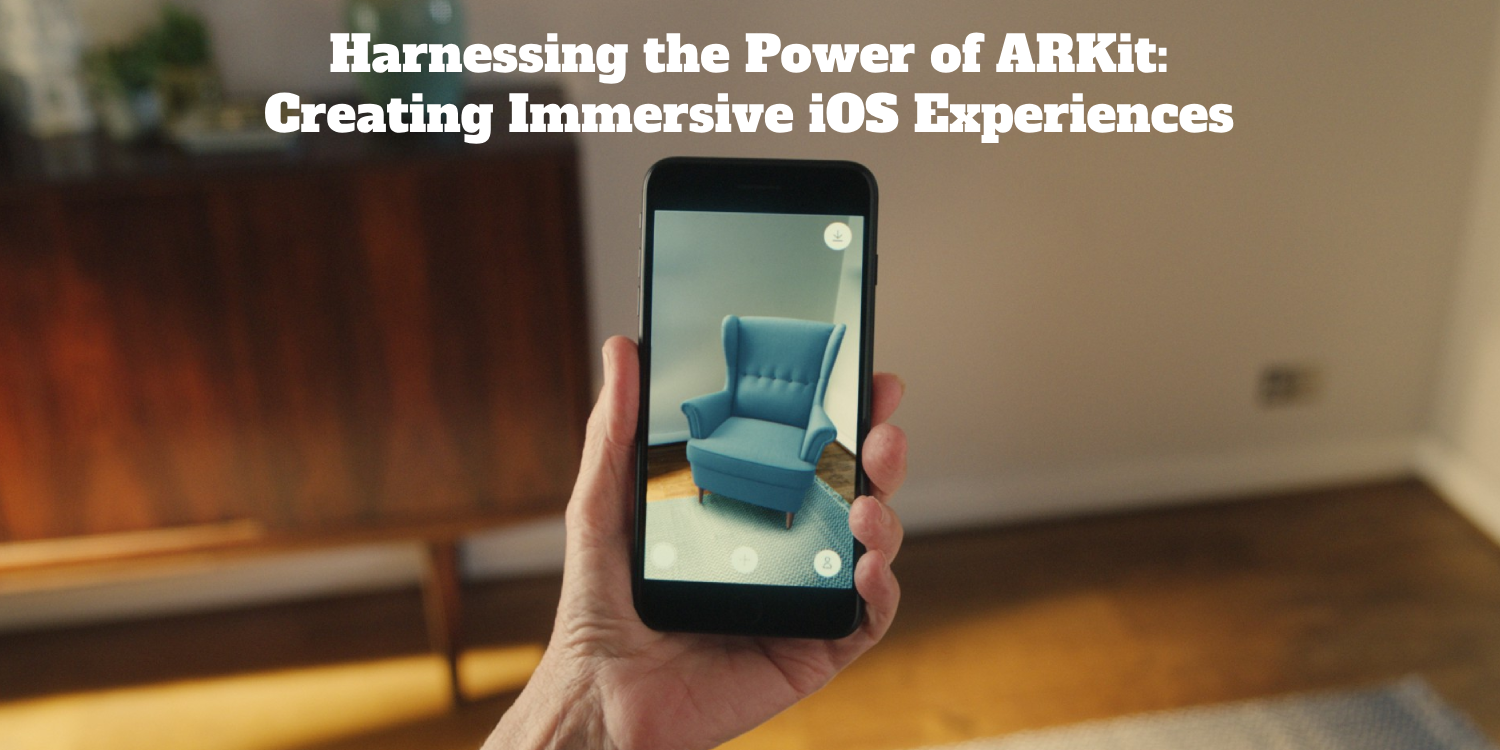Harnessing the Power of ARKit: Creating Immersive iOS Experiences

Augmented Reality (AR) has become a groundbreaking technology that seamlessly blends digital content with the real world, opening up a plethora of opportunities for developers to create immersive experiences. Among the various AR development platforms, ARKit stands out as a powerful toolset provided by Apple for creating AR experiences specifically tailored for iOS devices. In this article, we will delve into the capabilities of ARKit and explore how developers can harness its power to craft engaging and immersive experiences for iOS users.
Understanding ARKit:
ARKit is a framework developed by Apple that enables developers to integrate high-quality AR experiences into their iOS apps, making it a cornerstone of iOS app development services. It provides a range of features and functionalities that simplify the development process while delivering impressive results. Key components of ARKit include:
a. Scene Understanding: ARKit can analyze the scene captured by the device’s camera in real-time, allowing it to understand the geometry and layout of the environment. This enables developers to place virtual objects accurately within the physical space.
b. Motion Tracking: ARKit utilizes the device’s sensors to track its movement and orientation with high precision. This enables virtual objects to remain anchored in the real world, maintaining their position and orientation as the user moves around.
c. Light Estimation: ARKit can analyze the ambient lighting conditions in the environment, allowing virtual objects to realistically interact with light and shadows. This enhances the immersion of AR experiences by ensuring that virtual objects appear natural within the real-world context.
d. Rendering and Visual Effects: ARKit provides tools for rendering virtual objects with high fidelity and applying visual effects such as shadows, reflections, and occlusion. This helps create a seamless integration between the virtual and real elements of the scene.
e. Interaction and Input Handling: ARKit supports various input methods, including touch gestures, taps, and gestures recognized by the device’s sensors. This allows users to interact with virtual objects intuitively, enhancing the overall user experience.
Designing Immersive Experiences:
Creating compelling AR experiences requires careful consideration of design principles and user interaction. Here are some key factors to keep in mind:
a. User Interface (UI) Design: The user interface should be intuitive and unobtrusive, allowing users to focus on the AR content without distraction. UI elements such as buttons, menus, and tooltips should be thoughtfully placed within the scene to enhance usability.
b. Spatial Design: Designing virtual objects to interact seamlessly with the physical environment is crucial for immersion. Pay attention to factors such as scale, depth, and occlusion to ensure that virtual objects appear natural within the scene.
c. Animation and Motion: Animating virtual objects can enhance their realism and make the AR experience more engaging. Use animation techniques such as physics-based simulations and procedural animations to bring virtual objects to life.
d. Audio Design: Audio can play a significant role in enhancing the immersive experience of AR apps. Incorporate spatial audio techniques to create realistic soundscapes that complement the visual elements of the scene.
e. User Feedback: Providing clear and responsive feedback to user actions is essential for maintaining engagement. Use visual and auditory cues to indicate successful interactions and provide guidance to users as they navigate the AR experience.
Implementation with ARKit:
Implementing AR experiences with ARKit involves a series of steps, including scene setup, object placement, interaction handling, and optimization. Here’s a high-level overview of the development process:
a. Scene Setup: Start by configuring the AR session and setting up the scene with the necessary assets and components. This involves initializing the AR session, configuring tracking options, and loading any 3D models or textures needed for the AR experience.
b. Object Placement: Use ARKit’s scene understanding capabilities to place virtual objects within the physical environment. This may involve detecting surfaces such as floors, walls, and tables and positioning virtual objects accordingly.
c. Interaction Handling: Implement logic to handle user interactions with virtual objects, such as taps, gestures, and movements. ARKit provides APIs for detecting user input and responding accordingly, enabling developers to create intuitive and interactive experiences.
d. Visual Effects and Optimization: Enhance the visual quality of the AR experience by applying shaders, lighting effects, and other visual enhancements. Additionally, optimize the performance of the app to ensure smooth rendering and responsive interaction, especially on older or less powerful devices.
e. Testing and Iteration: Thoroughly test the AR experience on a variety of iOS devices to ensure compatibility and performance. Solicit feedback from users and iterate on the design and implementation based on their input, refining the experience to maximize engagement and immersion.
Get to Know about MyPayLA and Its Step-by-Step Process for LA Employees.
Case Studies and Examples:
To illustrate the potential of ARKit in creating immersive iOS experiences, let’s explore some real-world case studies and examples:
a. IKEA Place: IKEA Place is an iOS app that allows users to visualize furniture and home decor products in their own space using AR. Leveraging ARKit, the app accurately scales virtual furniture to match real-world dimensions and provides a realistic preview of how it would look in the user’s home.
b. Pokémon GO: Pokémon GO is a popular AR game that uses ARKit to bring Pokémon into the real world. Players can explore their surroundings, discover Pokémon, and engage in battles using their iOS devices. ARKit enables realistic rendering of Pokémon within the environment, creating an immersive gaming experience.
c. WWF Free Rivers: WWF Free Rivers is an educational AR app that allows users to explore virtual river ecosystems and learn about conservation efforts. ARKit is used to overlay interactive 3D models of rivers, fish, and wildlife onto the real-world environment, providing an engaging and educational experience for users of all ages.
d. Houzz: Houzz is a home design and renovation platform that offers an AR feature for visualizing products in the user’s home. Using ARKit, users can see how furniture, lighting, and other items would look in their space before making a purchase, helping them make informed decisions and visualize their design ideas.
e. Walk the Line: Walk the Line is an AR art installation that allows users to create virtual drawings in the real world. Using ARKit, users can draw lines and shapes in 3D space, which are then anchored to the physical environment and persist over time. This interactive experience encourages creativity and exploration in a novel way.
Future Trends and Opportunities:
As AR technology continues to evolve, there are exciting opportunities on the horizon for developers to push the boundaries of what’s possible with ARKit. Some emerging trends and areas of exploration include:
a. Spatial Computing: ARKit enables developers to create spatially-aware experiences that respond to the user’s environment in real-time. Future developments in spatial computing could further enhance the immersion and interactivity of AR experiences, blurring the line between the virtual and physical worlds.
b. Social AR: Collaborative and multiplayer AR experiences offer new possibilities for social interaction and shared experiences. ARKit provides tools for synchronizing AR content across multiple devices, opening up opportunities for collaborative gaming, social networking, and shared creative experiences.
c. AR Cloud: The concept of an “AR cloud” involves creating a persistent, shared spatial map of the world that can be accessed by multiple AR devices and applications. ARKit’s scene understanding capabilities lay the groundwork for building and interacting with the AR cloud, enabling seamless integration of virtual content into the real world.
d. Wearable AR: The emergence of AR glasses and other wearable devices presents new opportunities for delivering immersive AR experiences. ARKit’s capabilities can be leveraged to create AR apps and experiences specifically tailored for wearable devices, unlocking new use cases in fields such as enterprise, healthcare, and entertainment.
e. AI Integration: Integrating artificial intelligence (AI) technologies with ARKit could enhance the intelligence and realism of virtual objects within AR experiences. Future advancements in computer vision, natural language processing, and machine learning could enable more sophisticated interactions and dynamic content generation in AR apps.
Conclusion:
ARKit offers developers a powerful platform for creating immersive and engaging AR experiences for iOS users. By understanding the capabilities of ARKit and following best practices in design and implementation, developers can unlock the full potential of AR technology and deliver compelling experiences that captivate and delight users. As AR continues to evolve and mature, the possibilities for innovation and creativity in AR app development are virtually limitless, promising an exciting future filled with immersive experiences that seamlessly blend the virtual and real worlds.




